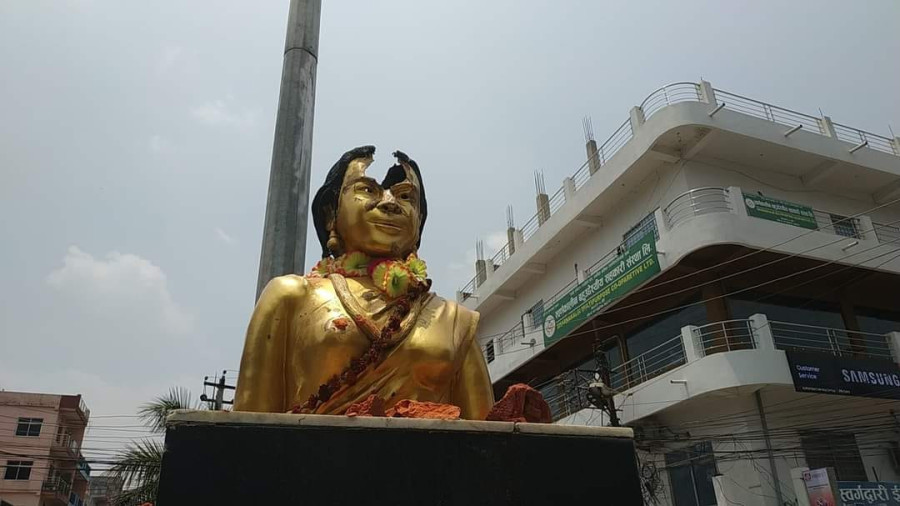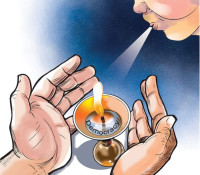Columns
History and memory
Nepal may have become a republic, but the public memory of the royal figures has not gone away.
Amish Raj Mulmi
Prithvi Chowk is perhaps one of Pokhara’s busiest crossings. The long distance bus stop is nearby, and one can find several buses lining up next to the crossing whose conductors call out their destinations at the top of their voices. Hotels, pharmacies, businesses and petrol pumps—you can find them all at Prithvi Chowk.
Except officially, the crossing is no longer named after the Shah king. Since 2008, it’s been called Lakhan Thapa Chowk, after the military leader from Gorkha who raised his banners against Jung Bahadur’s autocracy in 1876. Hanged at the Manakamana Temple—the very deity Thapa claimed divine inspiration from for his revolt—Lakhan Thapa remained an obscure figure until the 1990s, when he became "a major figure in Magar ethnic activism", and his "martyrdom" was subsequently claimed by the Maoists during the insurgency.
The old Shah king’s statue became a victim of the popular anti-monarchy uprising in 2006. Ethnic activists then renamed the crossing after Lakhan Thapa in 2008. But memory can often be a stronger attachment than history, for no resident of Pokhara actually calls the crossing Lakhan Thapa Chowk. Instead, it remains Prithvi Chowk to all and sundry. By putting up a statue of the rebel, Magar activists may have believed they had succeeded in changing history, but the memory of the old king lingers on, with or without the statue.
In Nepalgunj this past week, security forces clashed with royalists who have been unsuccessfully trying to place back a bust of King Birendra at Dhamboji Chowk, erstwhile known as Birendra Chowk. After security forces fired several tear gas shells, irate protestors damaged the statue of Dalit activist Setu Bishwokarma (BK), who lost her life in the 2006 revolution, at a different crossing that was earlier known as Gyanendra Chowk, named after the very king whose rule ushered in the end of monarchy.
At the heart of the clash in Nepalgunj—and the larger question of the unease over Nepal’s royal history–is the struggle between history and memory, as Indian scholar Pratap Bhanu Mehta recently wrote, albeit in a different context. "Memory has an affective dimension, it is supposed to move you, and constitute your identity. It draws the boundaries of communities. History is more detached, and the facts will always complicate both identity and community." Nepal may have become a republic, but the public memory of the royal figures has not gone away. Unless we come to terms with both our history as well as our memories, this contradiction will not be resolved.
Idle worship
The clash over a statue—or over history—is not unique to Nepal. In the United States, we have white supremacists fighting to retain the statues of Confederate generals and monuments that celebrate those who fought in favour of slavery during the Civil War. Historians have also called for the removal of the statue of Lord Clive—the East India Company general who spearheaded the British colonising campaign in South Asia—in the heart of London, suggesting its presence means the "British elite [had] not yet confronted its corporate and imperial past". Winston Churchill’s statue was defaced by anti-racism protestors in 2020 (with equal calls to recognise his complicity in the 1943 Bengal famine).
Closer home, in India, Hindutva activists have declared a war on India’s Mughal and Islamicate past and have renamed cities and streets that once carried the names of old emperors. The recent Hindi film Samrat Prithviraj—who, its posters claim, was India’s "last Hindu samrat"—wades into this murky territory of history versus memory, based as it is on Prithviraj Raso, a ballad that can at best be dated to the 16th century, almost 500 years after Mohammed Ghuri defeated Prithviraj in the second battle of Tarain. (One can almost hear VS Naipaul let out a sigh from beyond his grave despite his elegy for that "great Hindu kingdom of the south", the Vijayanagara empire, which lasted until 1565 CE.)
In Nepal, the contours of our struggle between history and memory rests primarily over whether to acknowledge the monarchy’s contributions to the country, or whether to erase it completely to celebrate the republic state. An objective reading of history demands that the monarchy’s successes—and its corruptibility, excesses and autocracy—be viewed from an equal lens. Our public narrative, however, desires to paint our kings—and our leaders—in a particular shade. So, Mahendra’s legacy is either that of a great nationalist, or a destroyer of an infant democracy. And Birendra is the eternal do-gooder king, with little thought wasted to the alleged rigging of the 1979 Panchayat referendum or elaboration required as to his incongruous "Zone of Peace" philosophy.
Fetishising history
History does not intend to create heroes or villains for the present; that is the realm of narrative and memory. However, when public memory begins to lay claim upon history, historical facts are glossed over in favour of a suitable narrative. As eminent historian Romila Thapar writes in Somanatha: The Many Voices of History, public memory is often an act of elite intervention that is "motivated by wishing to use the past to legitimise their present concerns". It is no wonder that speakers at prestigious events suggest Nepal as a nation-state existed 2,500 years ago (any historian would tell you the difference between claims and facts), while our leaders lay claim to Ram and Sita as real and historical personages. Ultimately, these fantasies give credence to our own ideologies and beliefs about where we’d like our history to begin from.
A similar fantasy has developed around the cult of the monarchy in Nepal. It is based on a manufactured memory that adulates the Shah dynasty, and is now a political tool that harnesses the discontent in a republic. While the royalists are right in arguing that history cannot be erased, their veneration of the monarchy is grounded in memory, not history. What helps them is the opacity of the Nepali monarchy (or its unwillingness to put itself up to public scrutiny). An unbiased historical study of any of the post-1950 kings would reveal their personalities in greater detail, but few would like to do so. Instead, a halo has been cultivated around an outdated institution whose downfall was brought about by its own failings.




 16.25°C Kathmandu
16.25°C Kathmandu















